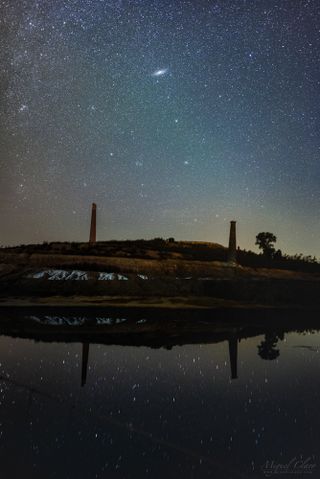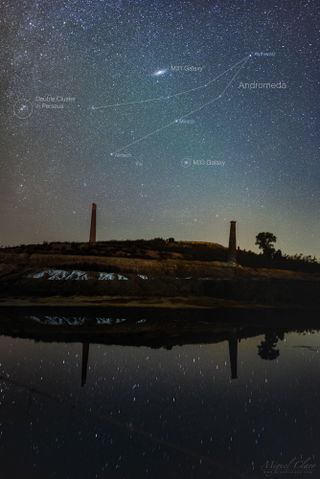Andromeda Galaxy Twinkles Above Old Mine in Stunning Nighttime View

Miguel Claro is a professional photographer, author and science communicator based in Lisbon, Portugal, who creates spectacular images of the night sky. As a European Southern Observatory photo ambassador, a member of The World At Night and the official astrophotographer of the Dark Sky Alqueva Reserve, he specializes in astronomical skyscapes that connect Earth and the night sky. Join him here as he takes us through his photograph "Andromeda Galaxy Shining above the Landscape."
In this star-speckled photo of the night sky, the Andromeda galaxy rises above a puddle of acid water in Achada do Gamo, part of the Dark Sky Alqueva Reserve near Mértola, Portugal. Also known as M31, the Andromeda galaxy is aligned between two chimneys from the century-old São Domingos Mine, highlighted against a faint greenish background from a thin band of airglow.
The great spiral galaxy Andromeda is a mere 2.5 million light-years from Earth, making it the closest large spiral galaxy to our own Milky Way. [Andromeda Galaxy Photos: Amazing Pictures of M31]

In very dark places, you can clearly distinguish this galaxy with the naked eye. Here's how to find it. Start by identifying Alpheratz, the brightest star in the Andromeda constellation (which contains the Andromeda galaxy) and the left-most star in a star pattern known as the Great Square of Pegasus. Then, move down two stars, and you'll end up on Mirach. Above Mirach is the much dimmer star Mu Andromedae. If you draw a line through the two stars and extend it upward, you'll bump into the Andromeda galaxy.
Very close to Andromeda, an even weaker star, called Nu Andromedae, is also visible. The annotated version above also shows galaxy M33 (the Triangulum Galaxy) and the well-known Double Cluster in the constellation Perseus.
This image was captured in a single shot using a portable tracking mount.
Editor's note: If you captured an amazing astronomy photo and would like to share it with Space.com for a story or gallery, send images and comments to managing editor Tariq Malik at spacephotos@space.com.
Get the Space.com Newsletter
Breaking space news, the latest updates on rocket launches, skywatching events and more!
To see more of Claro's amazing astrophotography, visit his website, miguelclaro.com. Follow us @Spacedotcom, Facebook and Google+. Original article on Space.com.
Join our Space Forums to keep talking space on the latest missions, night sky and more! And if you have a news tip, correction or comment, let us know at: community@space.com.
